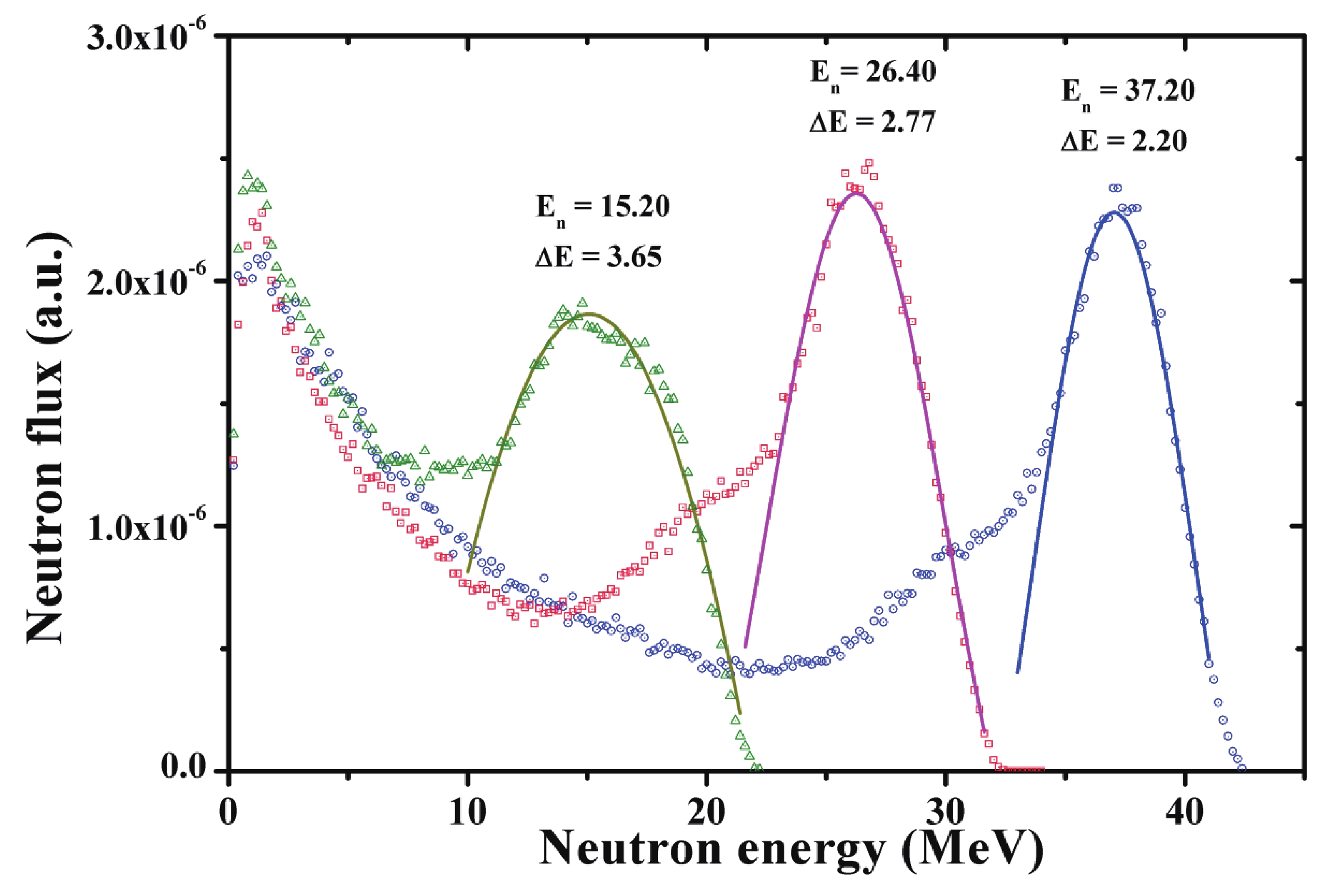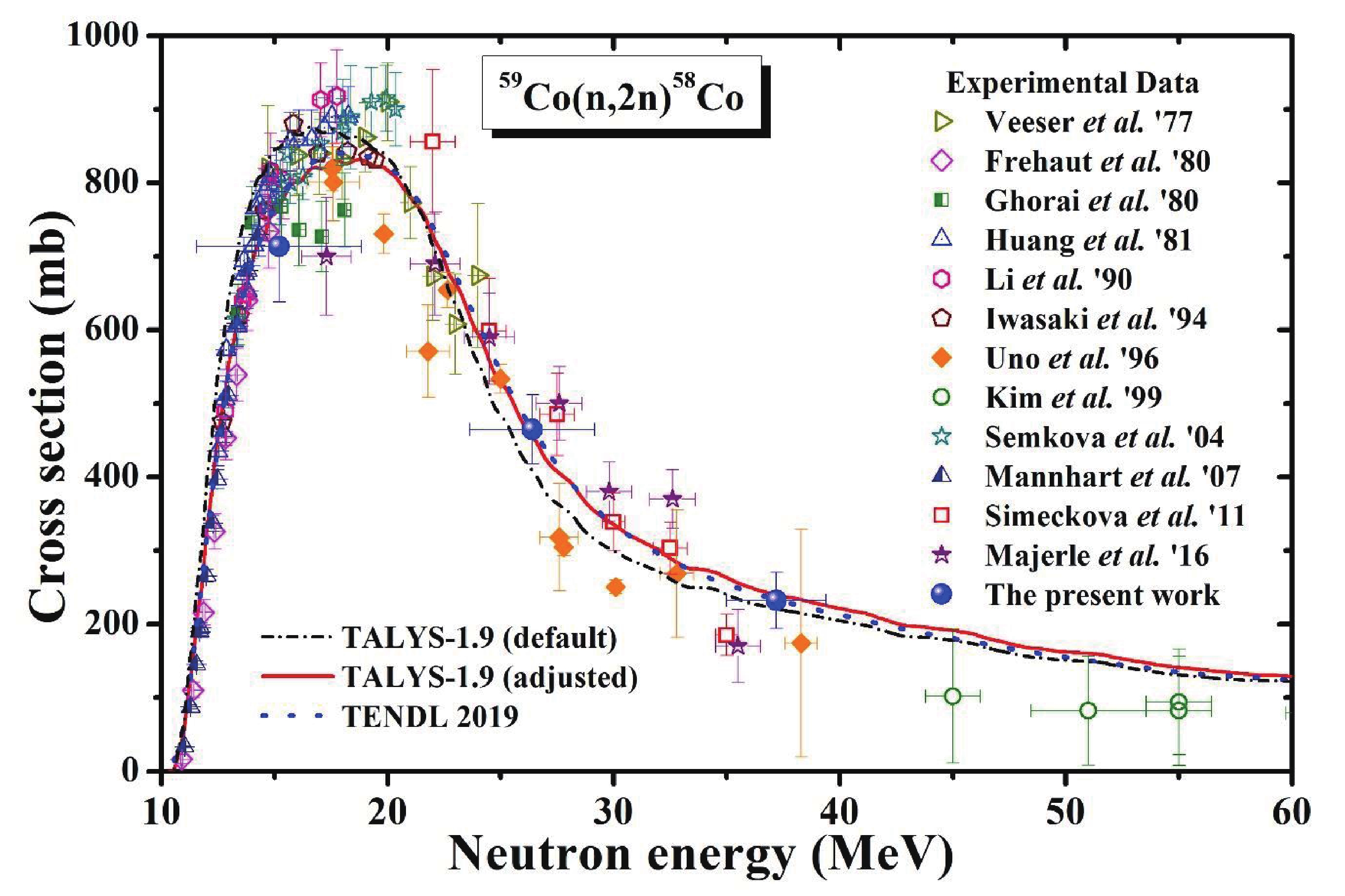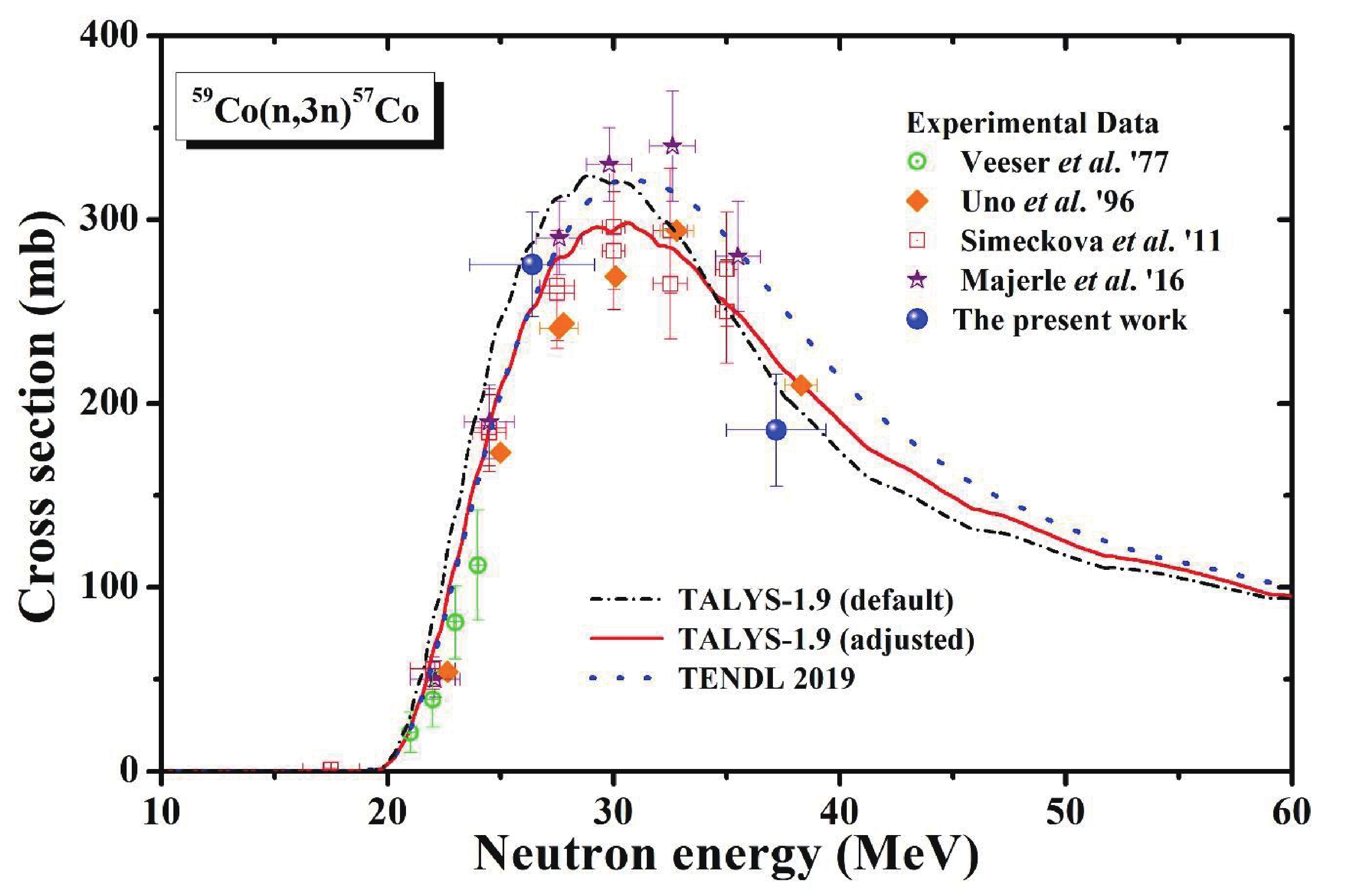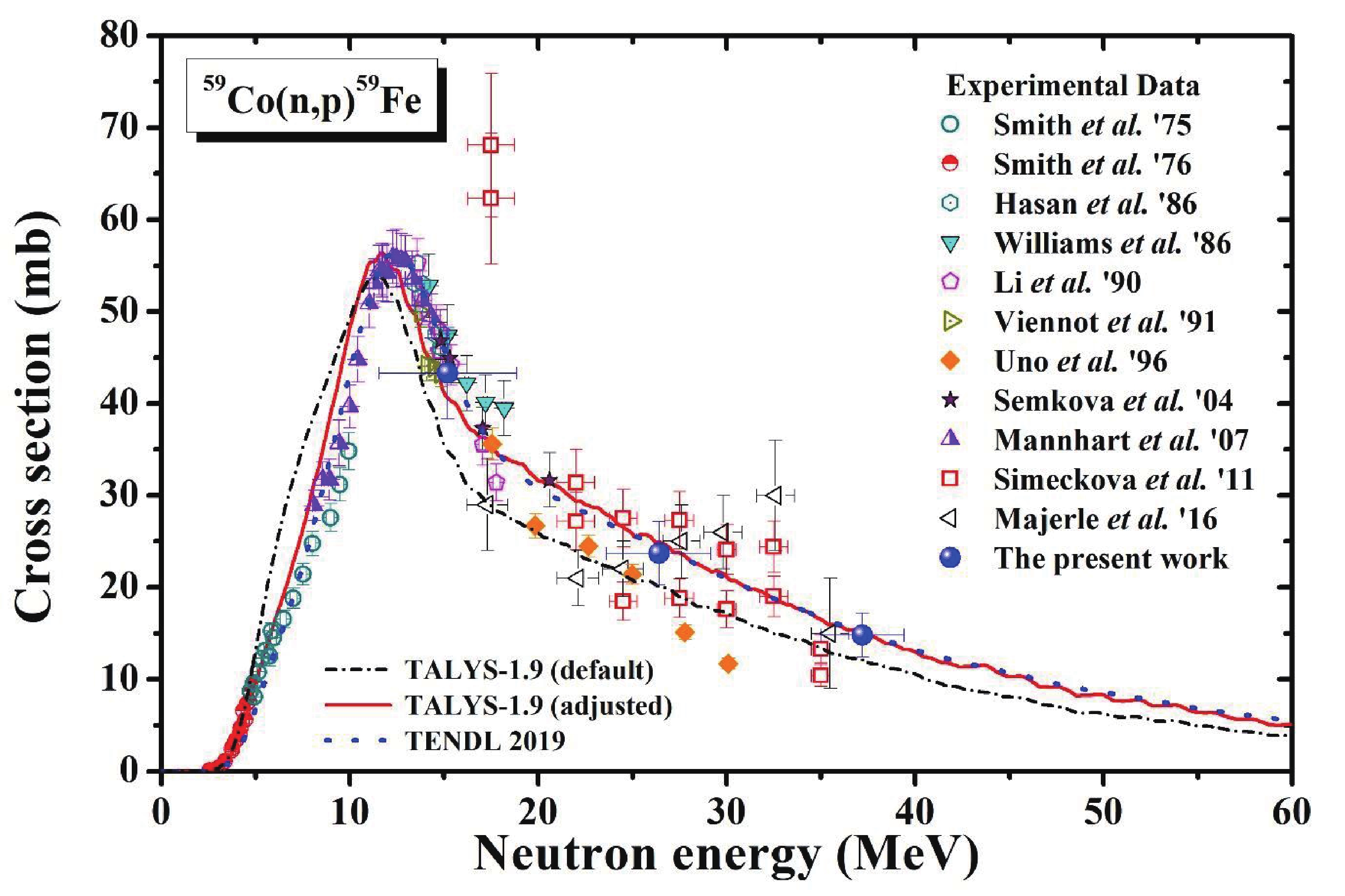HTML
--> --> -->The nuclear reaction cross sections induced by different energy neutrons and photons remains a major problem in applications such as data evaluation [6], applied nuclear physics, nuclear models, and nuclear reaction codes [7]. Therefore, an experimental study on the input parameters for nuclear reaction codes is necessary [8]. For these purposes, it is important to obtain more experimental measurements with high accuracy.
Numerous measured 59Co(n, x) reaction cross sections are available in the EXFOR data library [9]. According to EXFOR, the 59Co(n, 2n
 Figure1. (color online) Schematic view of experimental setup for irradiation facility.
Figure1. (color online) Schematic view of experimental setup for irradiation facility.We calculated the neutron spectra using the MCNPX 2.6.0 code [15] based on the following considerations. Uwamino et al. [16] measured neutron spectra from the p + 7Li (carbon backing) reaction with proton energies of 20, 25, 30, 35 and 40 MeV, which were simulated by Simakov et al. [17] using the MCNPX 2.6.0 code. The quasi-mono energetic neutron sources produced from the p+Be reaction was experimentally measured by Uwamino et al. [18] and estimated by Rakopoulos et al. [19] using the MCNPX 2.6.0 code at the Svedberg Laboratory (TSL). Novak et al. [20] suggested that the MCNPX 2.6.0 simulation could be used to generate the neutron spectrum for the p+Li and p+Be reactions. We calculated the neutron spectrum using the MCNPX 2.6.0 code for the Be(p, xn) reaction at a proton energy of 40 MeV and compared it with the experimental spectrum of Uwamino et al. [18]. The results were found to be in good agreement, except for the low neutron energy tail part. The neutron energy spectra for the p+Be reaction at proton energies of 25, 35, and 45 MeV were generated using the MCNPX 2.6.0 code and are presented in Fig. 2. The high energy distributions arose from the 9Be(p, n) reaction, and the low energy tail part resulted from the break-up reaction [21]. In the present work, most of the (n, x) reactions of the 59Co and 197Au originated from the region of higher energy neutrons. The neutron peak energy and its width in the neutron spectra were estimated by Gaussian fitting. The FWHM of the Gaussian fitting was used to estimate the widths of the different energy peaks. The obtained peak energies and their widths were 37.20±2.20, 26.40±2.77, and 15.20±3.65 MeV for the proton beam energies of 45, 35, and 25 MeV, respectively.
 Figure2. (color online) Neutron spectra calculated using MCNPX 2.6.0 code for proton beam energies of 25, 35 and 45 MeV.
Figure2. (color online) Neutron spectra calculated using MCNPX 2.6.0 code for proton beam energies of 25, 35 and 45 MeV.A.Neutron flux estimation
The neutron fluxes were estimated based on the photo-peak activities of the 355.68 keV γ-ray of 196Au from the 197Au(n, 2n) reaction at 25 MeV, 98.85 keV γ-ray of 195Au from the 197Au(n, 3n) reaction at 35 MeV, and 293.55 keV γ-ray of 194Au from the 197Au(n, 4n) reaction at 45 MeV proton beams, respectively. The neutron flux ${N_{\rm obs}} = C \cdot {\mkern 1mu} \int_{{E_{\rm th}}}^{{E_{\max }}} {{{\rm{\sigma }}_R}\left( {{E_n}} \right){\rm{\phi }}\left( {{E_n}} \right){\rm d}{E_n}} ,$ | (1) |
$C = \frac{{n{\mkern 1mu} {I_{\rm{\gamma }}}{{\rm{\varepsilon }}_{\rm{\gamma }}}\left( {1 - {{\rm e}^{ - {\rm{\lambda }}{\kern 1pt} {T_i}}}} \right){{\rm e}^{ - {\rm{\lambda }}{\kern 1pt} {T_c}}}\left( {1 - {{\rm e}^{ - {\rm{\lambda }}{T_{\rm clock}}}}} \right)}}{{{\rm{\lambda }}\left( {{T_{\rm clock}}/{T_{\rm count}}} \right)}},$ | (2) |
| S. No | Nuclide | Jπ | T1/2 | Decay mode | Eγ/keV | Iγ(100) | Contributing reaction | Eth-/MeV |   | ||
| 25 MeV | 35 MeV | 45 MeV | |||||||||
| Reactions studied | |||||||||||
| 1. | 58Co | 2+ | 70.86 d | EC | 810.78 | 99.00 | 59Co(n, 2n) | 10.63 | 0.87 | 0.36 | 0.20 |
| 2. | 57Co | 7/2? | 271.79 d | EC | 122.06 136.47 | 85.60 10.68 | 59Co(n, 3n) | 19.35 | ? | 0.79 | 0.39 |
| 3. | 56Co | 4+ | 77.27 d | EC | 846.77 1238.28 | 100.0 67.6 | 59Co(n, 4n) | 31.00 | ? | ? | 0.73 |
| 4. | 59Fe | 3/2? | 44.50 d | β? | 1099.25 1291.60 | 56.5 43.2 | 59Co(n, p) | 0.800 | 0.56 | 0.28 | 0.14 |
| 5. | 56Mn | 3+ | 2.58 h | β? | 846.77 | 98.9 | 59Co(n, α) | 3.800 | 0.74 | 0.24 | 0.18 |
| 6. | 54Mn | 3+ | 312.3 d | EC | 834.85 | 99.98 | 59Co(n, α2n) | 12.14 | ? | 0.61 | 0.59 |
| Monitor reactions | |||||||||||
| 7. | 196Au | 2? | 6.18 d | EC(93); β?(7) | 355.68 | 87.00 | 197Au(n, 2n) | 8.11 | 087 | ? | ? |
| 8. | 195Au | 3/2+ | 186.09 d | EC | 98.85 | 10.90 | 197Au(n, 3n) | 14.79 | ? | 0.67 | ? |
| 9. | 194Au | 1? | 38.02 h | EC | 293.55 | 10.4 | 197Au(n, 4n) | 23.21 | ? | ? | 0.58 |
Table1.Nuclear spectroscopic data of radio-nuclides from 59Co(n, x) and 197Au(n, xn) reactions and calculated factors (
The neutron fluxes were determined in the neutron energy region from the reaction threshold of the 197Au(n, xn; x=2-4) monitor reactions to the maximum neutron energies. The
${C_{br}} = \frac{{{M_{\rm obs}}}}{{{N_{\rm obs}}}} = \frac{{\displaystyle\int_{{E_P} - \Delta E}^{{E_P} + \Delta E} {{\sigma _R}({E_n}){\phi _n}({E_n}){\rm d}{E_n}} }}{{\displaystyle\int_{{E_{th}}}^{{E_{\max }}} {{\sigma _R}({E_n}){\phi _n}({E_n}){\rm d}{E_n}} }},$ | (3) |
${{\rm{\phi }}_{nP}} = \int_{{E_p} - \Delta E}^{{E_p} + \Delta E} {{{\rm{\phi }}_n}\left( {{E_n}} \right){\rm d}{E_n}} \approx \frac{{{C_{br}} \cdot {N_{\rm obs}}}}{{{{{\rm{\bar \sigma }}}_{RP}}}}.$ | (4) |
2
B.Reaction cross section calculation
The ${{\rm{\bar \sigma }}_{RP}} = \frac{{{C_{br}}}}{C} \cdot \frac{{{N_{\rm obs}}}}{{{{\rm{\phi }}_{nP}}}}.$ | (5) |
| En/MeV | Reaction cross section/mb | |||||
| 59Co(n, 2n)58Co | 59Co(n, 3n)57Co | 59Co(n, 4n)56Co | 59Co(n, p)59Fe | 59Co(n, α)56Mn | 59Co(n, α2n)54Mn | |
| 15.20±3.65 | 712.42±74.81 | ? | ? | 43.31±4.95 | 27.02±2.82 | ? |
| 26.40±2.77 | 464.60±47.19 | 275.65±28.48 | ? | 23.69±3.47 | 6.25±0.69 | 3.18±0.43 |
| 37.20±2.20 | 232.11±38.06 | 185.48±31.75 | 10.815±1.89 | 14.81±2.43 | 10.04±1.71 | 58.74±9.67 |
Table2.Measured cross sections of the 59Co(n, x) reactions.
${\left( {\frac{{\Delta {{\rm{\sigma }}_x}}}{{{{\rm{\sigma }}_x}}}} \right)^2} = \sum\limits_q {{{\left( {\frac{{\Delta {q_x}}}{{{q_x}}}} \right)}^2}}, $ | (6) |
The results obtained in this work, together with the literature data, are shown in Figs. 3-8. The theoretical results were obtained from the TALYS-1.9 code with default and adjusted parameters for each investigated radionuclide. In the theoretical calculation using the TALYS-1.9 code with the back-shifted Fermi gas model, the three input parameters ldmodel, Cstrip a (0.7), alphald (0.102), and betald (0.11) played a vital role. Thus, these three parameters were adjusted within their recommended limits to obtain the excitation functions with relatively good descriptions of the experimental data. We compared the measured cross sections with the theoretical values obtained from the TALYS-1.9 code and data from the TENDL 2019 library.
 Figure3. (color online) Comparison of 59Co(n, 2n)58Co reaction cross sections from present work with literature data and theoretical values. In this figure, TALYS-1.9 (default) and TALYS-1.9 (adjusted) indicate the theoretical data obtained using the TALYS-1.9 code with default and adjusted parameters, respectively.
Figure3. (color online) Comparison of 59Co(n, 2n)58Co reaction cross sections from present work with literature data and theoretical values. In this figure, TALYS-1.9 (default) and TALYS-1.9 (adjusted) indicate the theoretical data obtained using the TALYS-1.9 code with default and adjusted parameters, respectively. Figure4. (color online) Comparison of 59Co(n, 3n)57Co reaction cross sections from present work with literature data and theoretical values. In this figure, TALYS-1.9 (default) and TALYS-1.9 (adjusted) indicate the theoretical data obtained using the TALYS-1.9 code with default and adjusted parameters, respectively.
Figure4. (color online) Comparison of 59Co(n, 3n)57Co reaction cross sections from present work with literature data and theoretical values. In this figure, TALYS-1.9 (default) and TALYS-1.9 (adjusted) indicate the theoretical data obtained using the TALYS-1.9 code with default and adjusted parameters, respectively. Figure5. (color online) Comparison of 59Co(n, 4n)56Co reaction cross sections from present work with literature data and theoretical values. In this figure, TALYS-1.9 (default) and TALYS-1.9 (adjusted) indicate the theoretical data obtained using the TALYS-1.9 code with default and adjusted parameters, respectively.
Figure5. (color online) Comparison of 59Co(n, 4n)56Co reaction cross sections from present work with literature data and theoretical values. In this figure, TALYS-1.9 (default) and TALYS-1.9 (adjusted) indicate the theoretical data obtained using the TALYS-1.9 code with default and adjusted parameters, respectively. Figure6. (color online) Comparison of 59Co(n, p)59Fe reaction cross sections from present work with literature data and theoretical values. In this figure, TALYS-1.9 (default) and TALYS-1.9 (adjusted) indicate the theoretical data obtained using the TALYS-1.9 code with default and adjusted parameters, respectively.
Figure6. (color online) Comparison of 59Co(n, p)59Fe reaction cross sections from present work with literature data and theoretical values. In this figure, TALYS-1.9 (default) and TALYS-1.9 (adjusted) indicate the theoretical data obtained using the TALYS-1.9 code with default and adjusted parameters, respectively. Figure7. (color online) Comparison of 59Co(n, α)56Mn reaction cross sections from present work with literature data and theoretical values. In this figure, TALYS-1.9 (default) and TALYS-1.9 (adjusted) indicate the theoretical data obtained using the TALYS-1.9 code with default and adjusted parameters, respectively.
Figure7. (color online) Comparison of 59Co(n, α)56Mn reaction cross sections from present work with literature data and theoretical values. In this figure, TALYS-1.9 (default) and TALYS-1.9 (adjusted) indicate the theoretical data obtained using the TALYS-1.9 code with default and adjusted parameters, respectively. Figure8. (color online) Comparison of 59Co(n, α2n)54Mn reaction cross sections from present work with literature data and theoretical values. In this figure, TALYS-1.9 (default) and TALYS-1.9 (adjusted) indicate the theoretical data obtained using the TALYS-1.9 code with default and adjusted parameters, respectively.
Figure8. (color online) Comparison of 59Co(n, α2n)54Mn reaction cross sections from present work with literature data and theoretical values. In this figure, TALYS-1.9 (default) and TALYS-1.9 (adjusted) indicate the theoretical data obtained using the TALYS-1.9 code with default and adjusted parameters, respectively.2
A.59Co(n, 2n)58Co reaction
The long-lived radionuclide 58Co (T1/2=70.86 d) was produced from the 59Co(n, 2n)58Co reaction with a threshold energy of 10.63 MeV, which decayed to 58Fe with the EC (100%) process. The 58Co was identified by the intense γ-line of 810.77 keV (Iγ = 99%). The cross sections of the 59Co(n, 2n)58Co reaction at neutron energies of 15.20±3.65, 26.40±2.77, and 37.20±2.20 MeV were obtained and are presented in Table 2. The measured cross sections of the present work, along with the literature data [2, 27-37], data from the TENDL 2019 library [12], and the theoretical values obtained using TALYS-1.9 with default parameters (TALYS-1.9 (default)) and TALYS-1.9 with adjusted parameters (TALYS-1.9 (adjusted)) are shown in Fig. 3. The theoretical values obtained from TALYS-1.9 (default) were in good agreement with the experimental values up-to 20 MeV but were underestimated at higher neutron energies. However, the theoretical values from TALYS-1.9 (adjusted) agreed well with the present data. A comparison of the present data with the literature data [20-31] and theoretical values demonstrated good agreement at neutron energies of 26.40±2.77 and 37.20±2.20 MeV, which confirmed the reliability of the present technique. However, the present results at a neutron energy of 15.20±3.65 MeV was slightly lower than the literature data and theoretical values. This may be owing to the broad neutron spectrum for the proton energy of 25 MeV.2
B.59Co(n, 3n)57Co reaction
The long-lived radionuclide 57Co (T1/2= 271.79 d) was produced from the 59Co(n, 3n)57Co reaction with a threshold energy of 19.35 MeV, which decayed to 57Fe with the EC (100%) process. The cross section of the 59Co(n,3n)57Co reaction was measured by the intense γ-lines of 122.06 keV (Iγ = 85.6%) and 136.47 keV (Iγ = 10.68%). We counted two γ-lines with a long counting time to reduce the statistical uncertainties. We obtained the cross sections of the 59Co(n, 3n)57Co reaction at neutron energies of 26.40±2.77 and 37.20±2.20 MeV, and these values are listed in Table 2. The measured reaction cross sections of the present work, along with the literature data, TENDL-2019 data, and theoretical values obtained from TALYS-1.9 with default and adjusted parameters are presented in Fig. 4. It can be observed from Fig. 4 that the theoretical values from the TALYS-1.9 code with default parameters were overestimated compared to the experimental data below 35 MeV, whereas the data from the TENDL 2019 library were overestimated above 30 MeV. In the theoretical calculation, the two input parameters “Pshiftadjust” and “s2adjust” drastically changed the curve. The measured value at a neutron energy of 26.40±2.77 MeV was found to be in good agreement with the literature data [2, 27, 33, 37] and the theoretical values. However, the present value at the neutron energy of 37.20±2.20 MeV was slightly lower than the theoretical value.2
C.59Co(n, 4n)56Co reaction
The long-lived radionuclide 56Co (T1/2 = 77.27 d) was produced from the 59Co(n, 4n)56Co reaction with a threshold energy of 31.0 MeV, which decayed to 56Fe with the EC (100%) process. The radionuclide 56Co was identified via the 846.77 keV (Iγ = 100%) and 1238.28 keV (Iγ = 67.6%) γ-rays. In the present work, the 59Co(n, 4n)56Co reaction cross section was obtained at a neutron energy of 37.20±2.20 MeV and is displayed in Table 2. The measured reaction cross section, along with the literature data [2, 33, 34, 37, 38], TENDL 2019 data, and theoretical values from TALYS-1.9 with default and adjusted parameters are shown in Fig. 5. It can be observed from Fig. 5 that the theoretical data from the TALYS-1.9 (default) and TENDL 2019 data were overestimated compared to the experimental values. The theoretical value of the TALYS-1.9 (adjusted) was described better when estimate the cross section at low and higher neutron energies. The values reported by Kim et al. [34] were drastically underestimated in the other experimental values and the theoretical data. The theoretical data using the TALYS-1.9 code reproduced the present results very well.2
D.59Co(n, p)59Fe reaction
The radionuclide 59Fe was produced from the 59Co(n, p)59Fe reaction at neutron energies of 15.20±3.65, 26.40±2.77, and 37.20±2.20 MeV. The threshold energy for the 59Co(n, p)59Fe reaction was 0.8 MeV. The reaction product 59Fe (T1/2 = 44.5 d) decayed to 59Co through the β- decay (100%). It was identified by the intense γ-lines of 1099.25 keV (Iγ = 56.5.0%) and 1291.6 keV (Iγ = 43.2%). We obtained data with different cooling times and finally determined their average values. The cross sections for the 59Co(n, p)59Fe reaction from the present work are presented in Table 2. The present results were compared with the literature data [2, 31, 33, 35-37, 39-43], TENDL 2019 data, and calculated values from the TALYS-1.9 code, as illustrated in Fig. 6. The theoretical values from TALYS-1.9 (default) were overestimated below 10 MeV and underestimated above 10 MeV compared to the experimental data. The theoretical values from TALYS-1.9 (adjusted) and the TENDL 2019 data were consistent with the present data. The pre-equilibrium process started after the sharp peak of the compound nucleus. In particular, the “Pshiftadjust” parameter was used to obtain a relatively good description of the experimental data at the pre-equilibrium process. The theoretical results obtained from TALYS-1.9 with adjusted parameters at lower and higher energies were described better than those with default parameters. The present data agreed very well with the theoretical values obtained from TALYS-1.9 with adjusted parameters over the investigated energy range.2
E.59Co(n, α)56Mn reaction
The radionuclide 56Mn was produced from the 59(n, α)56Mn reaction with a threshold energy of 3.80 MeV. The radionuclide 56Mn (T1/2 = 2.58 h) underwent 100% β- decays to produce 56Fe. It was identified by an intense γ-line of 846.77 keV (Iγ = 98.9%). We measured the cross sections of the 59(n, α)56Mn reaction at neutron energies of 15.20±3.65, 26.40±2.77, and 37.20±2.20 MeV, as listed in Table 2. The present data were compared with the literature data [2, 29-31, 33, 36, 37, 44-48], data from the TENDL 2019 library, and theoretical values from TALYS-1.9 with default and adjusted parameters, as shown in Fig. 7. Fig. 7 indicates that the theoretical data from the TALYS-1.9 code with default parameters were overestimated compared to the experimental values. The theoretical calculations using the TALYS-1.9 code with adjusted parameters, such as the “Pshiftadjust” and “s2adjust” parameters, were used to obtain a relatively good description of the experimental data at the pre-equilibrium process. We obtained good agreement among the different experimental values. The calculated values using TALYS-1.9 with adjusted parameters at lower and higher neutron energies described the experimental data better than those with default parameters. Relatively good agreement was obtained between the present data and the theoretical data obtained from TALYS-1.9 with adjusted parameters in the investigated energy range.2
